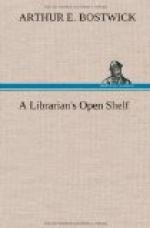We are accustomed to regard what we call standard literature as necessarily the standard of innumerable centuries to come, forgetful of the fact that other so-called standards have “had their day and ceased to be.” Some literature lasts a century, some a year, some a week; where shall we draw the line below which all must be condemned as ephemeral? Is it not possible that all literary work that quickly achieves a useful purpose and having achieved it passes at once out of sight, may really count for as much as one that takes the course of years to produce its slow results? The most ephemeral of all our literary productions—the daily paper—is incalculably the most influential, and its influence largely depends on this dynamic quality that has been noted—the penetrative power of a thing of light weight moving at a high speed. And this penetrative power effective literature must have to-day on account of the vastly increased mass of modern readers.
Reading is no longer confined to a class, it is well-nigh universal, in our own country, at least. And the habit of mind of the thoughtful and intent reader is not an affair of one generation but of many. New readers are young readers, and they have the characteristics of intellectual youth.
Narrative—the recapitulation of one’s own or someone else’s experience, the telling of a story—is the earliest form in which artistic effort of any kind is appreciated. The pictorial art that appeals to the young or the ignorant is the kind that tells a story—perhaps historical painting on enormous canvasses, perhaps the small genre picture, possibly something symbolic or mythological; but at any rate it must embody a narrative, whether it is that of the signing of a treaty, a charge of dragoons, a declaration of love or the feeding of chickens. The same is true of music. The popular song tells something, almost without exception. Even in instrumental music, outside of dance rhythms, whose suggestion of the delights of bodily motion is a reason of their popularity, the beginner likes program music of some kind, or at least its suggestion. So it is in literature. With those who are intellectually young, whether young in years or not, the narrative form of expression is all in all. It is, of course, in all the arts, a most important mode, even in advanced stages of development. We shall never be able to do without narrative in painting, sculpture, music and poetry; but wherever, in a given community, the preference for this form of expression in any art is excessive, we may be sure that appreciation of that form of art is newly aroused. This is an interesting symptom and a good sign. To be sure, apparent intellectual youth may be the result of intellectual decadence; there is a second as well as a first childhood, but it is not difficult to distinguish between them. In general, if a large proportion of those in a community who like to look at pictures, prefer such as “tell




